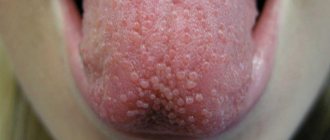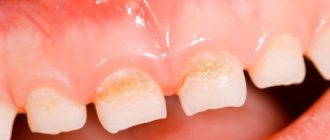Main symptoms
Sometimes the presence of cracks and grooves in the tongue is not accompanied by unnatural or painful sensations and can only be detected during examination by a dentist, ENT specialist or therapist. But this doesn't always happen. Patients often complain of the following related problems:
- pain;
- burning sensation;
- feeling that the tongue is loose;
- there is blood and ichor;
- elevated temperature;
- swelling and itching appeared;
- it becomes painful to chew;
- there is a problem with speech;
- increased salivation appeared;
- change in natural color;
- taste disturbance;
- the appearance of an unpleasant odor.
If cracks appear on the tongue, and the phenomenon is accompanied by one of the listed symptoms, then they speak of a progressive disease. This inflammatory process is referred to as glossitis; the prognosis for recovery from it is usually favorable. The appearance of erosions, furrows and ulcers indicates damage to the deep parts of the tongue. In this case, you should definitely contact a specialist.
Sometimes the tongue cracks and becomes covered with ulcers due to general damage to the ENT organs. Thus, tonsillitis or fungal pharyngitis can cause swelling and the appearance of white grooves. This condition is not isolated as an independent disease. Treatment in such cases begins with eliminating the underlying problem.
Methods for eliminating a short frenulum of the tongue
A short frenulum of the tongue is corrected surgically. The most modern method is cutting the frenulum of the tongue with a laser, since there is less pain, the operation is almost bloodless, the wound is sterile and heals quickly.
Operations can be different:
- Frenuloplasty of the tongue is plastic surgery of the frenulum of the tongue with mobilization. Mobilization is the preparation of the edges of the wound for a screed by pulling the tongue forward and upward; flap formation is often used in plastic surgery. In most cases, frenuloplasty of the tongue is the most favorable way to lengthen the frenulum for both healing and restoration of the tongue.
- Frenulotomy is a dissection of the frenulum, usually done in the maternity hospital by simply cutting the frenulum without sutures.
- Frenulectomy - excision of the frenulum. During this operation, the doctor cuts the tissue wedge-shaped in several places, then applies sutures, but does not mobilize the tongue. This is a disadvantage of the method.
Obviously, each case is individual and the choice of method should be made by a specialist.
Types of glossitis
In total, there are more than ten types of glossitis, three of which are accompanied by the appearance of cracks in the tongue. They have quite pronounced visible differences. To independently diagnose the type, you can compare the current state of the tongue with photos of classic manifestations of the disease.
Folded glossitis takes its name from the main external manifestation - the presence of folds. Sometimes, with this type of disease, a cracked tongue is present from birth. If it does not hurt, is not loose and there are no other unpleasant sensations, then the condition is considered normal. However, with deep cracks in the tongue, treatment is still necessary.
The problem of a folded tongue is often only of an aesthetic nature, although people with this feature are recommended to have constant monitoring by a dentist.
Desquamative glossitis is characterized by focal damage to the surface with almost imperceptible shallow cracks. The papillae desquamate and a whitish heterogeneous layer forms. The affected areas quickly recover, acquiring a natural color, and those adjacent to them become inflamed. The geometry of white areas (plaque) on the surface often changes. In advanced cases, due to the large number of cracks, a person feels the tongue is loose.
Diamond-shaped glossitis is characterized by the presence of a rhombic or oval-shaped area of red-blue color. It is located in the middle of the tongue, in the region of the posterior third. The tongue cracks in the center, so that the entire affected area seems to be divided into two parts. This type can be chronic, and during exacerbations, pain and burning begin.
What it is
Officially, painful cracks on the tongue and along the edge of the tongue are called glossalgia. This is a fairly common neurosomatic disease.
Most common symptoms:
- dryness in the tongue area;
- itching and burning;
- swelling;
- soreness.
The insidiousness of glossalgia is that it does not go away on its own; without appropriate treatment it is impossible to get rid of a crack in the tongue.
At an early stage of the disease, the doctor may not notice pronounced cracks in the tongue, since they are microscopic and mainly manifest themselves as burning and pain. If you do not respond to this symptom in a timely manner, over time a crack may form at the tip or in the middle of the tongue, longitudinally, as well as cracks under the tongue and on the sides. In this case, the doctor also notes swelling and swelling of the tongue, atrophy of the salivary glands and filiform papillae on the surface of the tongue. The sooner you start treatment, the easier it is to get rid of glossalgia, so if you have cracks in your tongue, you should immediately consult a doctor.
Localization of cracks
The position of the cracks is not random. Localization is divided into three types, each of which is caused by specific problems. You can independently identify the type of localization by assessing the position of the cracks in the tongue: in the center, on the sides or at the tip.
The presence of cracks only at the tip of the tongue indicates the following causes of the problem:
- Thermal damage. Hot food first comes into contact with the tip of the tongue and causes major damage to it. Often the problem is contact with a hot metal spoon.
- Chemical damage. Occurs from contact with spicy, sour foods or corrosive substances.
- Physical impact. The tip can crack due to an incorrect bite or a cut on the sharp protruding parts of the incisors and canines.
Photo: cracks on the sides of the tongue
The formation of cracks in the tongue in the middle has a different reason, since it is almost impossible to injure this area without touching the periphery. This means that inflammation is an indicator of pathology or disease of internal organs. In addition, the formation of cracks in the center is possible when the middle area dries out, local circulation is impaired, or the immune system is weakened. There may be only one crack; upon examination, it appears as if the tongue has split into two parts.
The presence of cracks on the sides of the tongue can be caused by various reasons. If the inflammatory process is present on the side on one side, then this means physical damage from the sharp edges of small and large molars or dentures. If the tongue is cracked on both sides, it means that there are serious malfunctions in the functioning of the body , where glossitis acts only as an indicator of pathology.
Causes of cracks
Folded glossitis can be detected immediately after the birth of the child. The cause is most often a hereditary predisposition, rather than a sign of any disease. Therefore, if a child has a cracked tongue, this is not yet a reason to start urgent treatment. Only if the grooves bleed or other problems are present should you seek medical help.
The causes of cracks in the tongue can be very different, but they all require diagnosis and elimination. The first type of prerequisites is of a dental nature; the problem arises due to the following phenomena:
- cuts to the organ by sharp edges of teeth or an incorrectly selected prosthesis;
- if diseases of the oral cavity or ENT organs are not treated for a long time;
- irritation from eating excessively hot, spicy, salty or sour foods;
- allergic reaction to medications or toothpaste taken.
The second type of reason, which explains why cracks appear on the tongue, can be described as indicator. It indicates the presence of a disease of the organs or circulatory system.
Another reason for the appearance of cracks in the tongue in adults may be a banal vitamin deficiency, leading to a decrease in immunity. It is usually observed in the following cases:
- the onset of the period from February to April, when there is no supply of vitamins from fresh vegetables and fruits for a long time;
- period of growing up with changes in hormonal levels;
- breastfeeding period.
Tongue frenulum surgery
At what age should a tongue tie be operated on?
In infancy, the frenulum looks like a thin membrane and has no blood vessels or nerve endings. Plastic surgery is performed with one movement of a scalpel without anesthesia and subsequent treatment. After this simple procedure, the mother just needs to give the baby the breast; mother's milk will prevent any hygienic problems in the incision area. But this procedure may negatively affect future tongue movements due to the resulting scar. Therefore, if it is possible to avoid such a procedure, it is better to postpone the resolution of the issue to a later date.
For the mother, the main thing in this situation is to establish the process of breastfeeding.
With age, the membrane becomes stronger, blood vessels appear in it, and it is no longer possible to correct this as simply as in infancy. Usually, at a later age, a shortened frenulum is discovered during an appointment with a speech therapist, pediatrician or dentist. Signs of this phenomenon may include problems with speech, since the baby cannot make sounds that require touching the tip of the tongue to the palate or teeth. He begins to burr or lisp. Parents may also notice that the child has problems sticking his tongue out of the mouth.
Doctors recommend waiting until surgery
If a slightly shortened frenulum is detected, even at an early age, doctors recommend waiting until surgery. It can lengthen on its own as it grows.
Plastic surgery – frenuloplasty
But if this did not happen before primary school, a full-fledged plastic surgery called frenuloplasty is required. It is done under general or local anesthesia, depending on the perseverance and age of the child. The operation itself is extremely simple and does not take long, so if possible it is better to limit yourself to local anesthesia. The frenulum is cut at the tongue and moved a little further, and then sutured to functional size.
Postoperative period
The postoperative period at this age, unfortunately, requires special oral care, sometimes even taking antibiotics. The stitches are removed within a week. Once the incision and suture sites have completely healed, a long period of exercise with a speech therapist is required to ensure that the child develops proper language skills.
If a child is diagnosed with a shortened frenulum of the tongue, do not rush into action.
Early excision, although seemingly simpler, may cause speech problems later. Therefore, first, find a good pediatrician and consult to choose the optimal age of the small patient. And remember, such a problem can be solved in any case, it is only important to choose the method you need.
If you have any doubts about your child’s tongue frenulum, come to the A.Dent children’s clinic, here you will receive a comprehensive consultation and, if necessary, a course of treatment will be prescribed.
Medical assistance
If the tongue is cracked and hurts, is swollen on the sides, or there are other signs of the progressive development of the disease, then treatment must be started immediately . A protracted process can progress to a more complex stage, up to necrosis or oncology.
Constant inflammation causes intoxication of the body and is fraught with the entry of pus into the gastrointestinal tract.
Only a doctor can give a qualified answer to the question of why the tongue cracks. Due to the variety of possible causes of cracks in the tongue, the problem arises of which doctor to contact in order to establish the correct diagnosis and prescribe adequate treatment. First of all, you need to get examined by a dentist. This is necessary to identify prerequisites associated with problems in the oral cavity, or to exclude such a scenario.
If, as a result of a dental examination, the cause of cracks in the tongue was not identified, this means that the problem may be caused by diseases of the internal organs. Usually the patient knows or guesses from how he feels about its existence. Depending on the type of possible pathology, you need to contact a specialized specialist.
If there are no obvious signs of illness, you need to consult a therapist or pediatrician. You can first take a general blood test and do an ultrasound of the internal organs.
Therapeutic treatment
First of all, to get rid of glossitis, it is necessary to diagnose and determine the nature of its occurrence, since it is impossible to cure cracks in the tongue without eliminating the provoking factor. The treatment method should be developed by a specialist in the underlying disease. Additionally, symptomatic treatment of the entire oral cavity is used, depending on the type of lesion. To do this, use the following methods:
- drug therapy aimed at improving local blood circulation in the tissues of the oral cavity;
- prescribing physiotherapeutic procedures such as electrophoresis;
- use of antiviral ointments;
- the use of drugs that stimulate epithelial restoration;
- taking antibiotics for fungal complications;
- administration of local anesthetics for severe pain.
Treatment
The formation of transverse or longitudinal grooves is an irreversible process. This pathology in itself is not dangerous and therefore does not require treatment. However, patients with this feature must take good care of their oral hygiene. Plaque and dead epithelial cells remaining in the folds will lead to the proliferation of bacteria in the oral cavity and bad breath. In cases of advanced inflammatory processes or fungal infections, drug treatment may be indicated. For these purposes, antimycotic drugs and immunocorrectors are prescribed. To clean the folds and remove the source of infection, it is recommended to use antibacterial and antiseptic drugs, solutions for rinsing and medicinal baths. Painful sensations in the affected areas are also relieved by rinsing in addition to applications with an anesthetic or vitamin solution. Surgical treatment is indicated only in rare cases. It is used when the affected organ increases in size too much. During the operation, the dentist performs a wedge-shaped excision of part of the tongue.
Use of traditional medicine
At home, you can use well-known methods to help heal wounds in the mouth, eliminate pain, relieve swelling and other symptoms. However, before treating cracked tongue with folk remedies, you need to ensure their compatibility with the prescribed medications.
The most effective are the following recipes:
Herbal infusion of chamomile, celandine, sage and calendula. For adults, you can add St. John's wort. Take after meals in the form of baths or lotions. Promotes wound healing and relieves swelling.- Compresses from fermented milk products. Soften scars and scabs. The procedure should be done in the morning for 15 minutes.
- Sea buckthorn or olive oil. In the morning you need to drop a few drops on the mucous membrane and in the middle of the tongue, then do not drink or eat for 15 minutes. Softens dry formations on the tongue and mucous membranes.
- Honey. Has wound-healing and antimicrobial effects. A piece of the product can be placed in the middle of the tongue and dissolved. Gives a good effect if cracks bleed.
- Propolis tincture (for adults only). The strongest disinfectant: has antimicrobial, antibacterial and anti-inflammatory effects. Since alcohol tincture cannot be used in its pure form if there are open wounds, you need to dilute 1 teaspoon in 100 grams of warm tea. Drink after meals.











